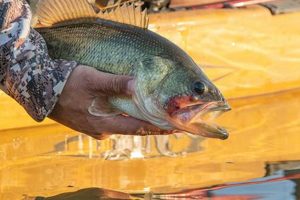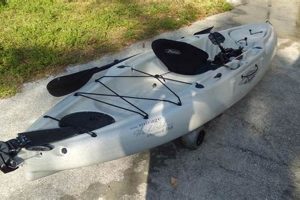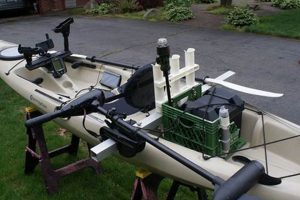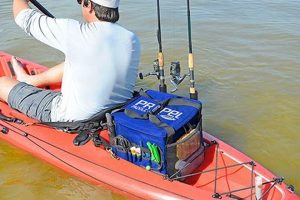This activity involves using a kayak to fish in the waters near Capitola, California. The protected cove of Capitola Beach and the nearby kelp forests and open ocean offer a diverse range of fishing opportunities, from surf perch near the shore to rockfish and lingcod in deeper waters. Anglers can launch their kayaks from the beach or the Capitola Wharf, accessing various fishing grounds within a short paddle.
The calm waters within the cove are ideal for novice kayak anglers, while the more adventurous can explore the kelp forests and deeper waters just offshore. The proximity to Monterey Bay provides access to nutrient-rich waters, supporting abundant marine life and enhancing the chances of a successful catch. This pursuit offers a unique blend of recreation, exercise, and connection with nature, allowing participants to experience the beauty of the Pacific coastline while engaging in a challenging and rewarding sport. The area’s long-standing maritime heritage adds a layer of cultural significance to the experience.
Further exploration will cover topics such as necessary equipment, ideal fishing locations around Capitola, seasonal variations in fishing opportunities, relevant regulations, and safety considerations specific to the area.
Tips for Kayak Fishing in Capitola
Successful kayak fishing in Capitola requires preparation and awareness. These tips offer guidance for a safe and productive experience.
Tip 1: Check Weather and Tide Conditions: Before launching, consult marine forecasts for wind speed, wave height, and tidal currents. Favor calm conditions, especially for beginners. Strong winds and currents can create hazardous situations.
Tip 2: Choose Appropriate Kayak and Gear: Select a kayak designed for stability and fishing, equipped with rod holders and storage. Essential gear includes a paddle leash, personal flotation device (PFD), and appropriate fishing tackle.
Tip 3: Obtain Necessary Licenses and Permits: Ensure compliance with California fishing regulations by obtaining a valid fishing license and any required permits for specific species or areas.
Tip 4: Familiarize Oneself with Local Regulations: Be aware of any specific regulations regarding fishing areas, catch limits, and allowed fishing methods within Capitola and the Monterey Bay Sanctuary.
Tip 5: Practice Kayak Handling Skills: Before venturing out, practice basic kayak maneuvering skills in calm waters. This includes paddling, turning, and maintaining balance in various conditions.
Tip 6: Prioritize Safety: Always wear a PFD, carry a whistle or other signaling device, inform someone of fishing plans, and be mindful of other boat traffic.
Tip 7: Respect the Environment: Practice catch-and-release when appropriate, dispose of fishing line and other waste responsibly, and minimize disturbance to marine life and their habitats.
Adhering to these guidelines will contribute to a safer, more enjoyable, and environmentally responsible fishing experience.
By combining preparation with respect for the environment and regulations, anglers can fully appreciate the unique opportunities offered by kayak fishing near Capitola.
1. Location
Capitola Bay’s unique characteristics significantly influence the nature and feasibility of kayak fishing within its waters. The bay’s sheltered nature, created by its crescent shape and the protective Soquel breakwater, generally results in calmer waters compared to the open ocean. This calmer environment provides favorable conditions for kayak fishing, particularly for those with less experience navigating rougher seas. The reduced wave action and currents contribute to increased stability and maneuverability, allowing anglers to focus on fishing rather than constantly battling challenging conditions. Furthermore, the bay’s relatively shallow depths and varied underwater terrain, including kelp forests and rocky reefs, create diverse habitats that attract a variety of fish species, enhancing fishing prospects.
For example, the kelp forests provide shelter and foraging grounds for rockfish, while the sandy bottom areas attract halibut and other bottom-dwelling species. The proximity of the Capitola Wharf also offers additional fishing opportunities, as the structure itself attracts various fish. This combination of calm waters, diverse habitats, and accessible launch points makes Capitola Bay a prime location for kayak fishing, accessible to anglers of varying skill levels. The bays sheltered environment allows for year-round fishing opportunities, although seasonal variations in fish populations and weather conditions can influence the optimal times for targeting specific species.
Understanding the interplay between Capitola Bay’s features and kayak fishing practices is crucial for a successful and enjoyable experience. Awareness of the bay’s layout, including potential hazards like submerged rocks and changing tides, is essential for safe navigation. Recognizing the distribution of different habitats within the bay can inform strategic choices regarding fishing locations and techniques. Ultimately, this knowledge allows anglers to maximize their chances of success while minimizing risks and promoting responsible interaction with the marine environment.
2. Activity
Kayak fishing, as an activity, forms the core of the Capitola kayak fishing experience. It represents the active pursuit of fish from a kayak within the specific context of Capitola’s waters. This activity dictates the necessary equipment, skills, and knowledge required for a successful outing. The choice of kayak, fishing rods, tackle, and safety gear is directly determined by the activity itself. Furthermore, understanding tidal flows, local fish behavior, and appropriate fishing techniques are essential components of effective kayak fishing in any location, including Capitola.
For instance, an angler targeting rockfish near the Capitola Wharf might opt for a sit-on-top kayak for stability and maneuverability around the structure, coupled with heavier tackle suited for deeper water fishing. Conversely, someone fishing for surfperch in the shallower waters near the beach might choose a lighter, more agile kayak and lighter tackle. The specific activitykayak fishingdictates these choices, influencing the overall experience. The understanding of kayak fishing as an activity also informs responsible angling practices. Minimizing environmental impact through proper waste disposal, adhering to catch limits, and practicing catch-and-release contribute to the sustainability of the fishery and the preservation of Capitola’s coastal ecosystem.
Successful Capitola kayak fishing necessitates a comprehensive understanding of kayak fishing as an activity. Proficiency in paddling, casting, retrieving, and landing fish from a kayak, combined with an awareness of local regulations and environmental considerations, defines the essence of this pursuit. This knowledge equips anglers to navigate Capitola’s waters safely and effectively, maximizing their chances of a rewarding experience while contributing to the preservation of this unique coastal environment.
3. Target
Targeting nearshore species is a defining characteristic of kayak fishing in Capitola. The accessibility of these species from a kayak contributes significantly to the popularity and feasibility of this activity within the bay. The proximity of diverse habitats, including kelp forests, rocky reefs, and sandy bottom areas, supports a variety of nearshore fish populations, creating ample fishing opportunities for kayak anglers.
- Rockfish
Various rockfish species inhabit the kelp forests and rocky reefs prevalent in Capitola Bay. These fish, including black rockfish, blue rockfish, and olive rockfish, are targeted by kayak anglers using a variety of techniques, such as bottom fishing with live bait or lures. Their presence in relatively shallow, accessible waters makes them a popular target for kayak anglers.
- Surfperch
Surfperch, including barred surfperch and walleye surfperch, are commonly found in the surf zone and shallow waters along Capitola Beach. These fish are readily accessible from kayaks launched directly from the beach. Light tackle and various bait options, such as sand crabs or mussels, are often used to target these species.
- Halibut
California halibut, while less common than rockfish or surfperch, are also present in Capitola Bay. These fish prefer sandy bottom areas and can be targeted by kayak anglers using live bait or artificial lures. Landing a halibut from a kayak presents a unique challenge and rewarding experience.
- Lingcod
Lingcod, another sought-after species, inhabits deeper rocky areas within and near Capitola Bay. Kayak anglers targeting lingcod often venture slightly further offshore, employing heavier tackle and techniques similar to those used for rockfish. Their aggressive nature and size make them a prized catch.
The variety of nearshore species available to kayak anglers in Capitola significantly contributes to the appeal of this activity. The accessibility of these species, combined with the bay’s favorable conditions for kayak fishing, creates a unique and rewarding experience for anglers of varying skill levels. Understanding the specific habitats and preferred feeding patterns of these nearshore species is crucial for a successful outing. This knowledge, coupled with appropriate tackle and techniques, allows anglers to target specific species effectively while minimizing environmental impact and promoting responsible angling practices within Capitola’s coastal ecosystem.
4. Gear
Appropriate gear selection directly impacts the success and safety of kayak fishing in Capitola. The kayak itself serves as the primary platform and requires careful consideration. Stability, maneuverability, and storage capacity are key factors. Sit-on-top kayaks are often preferred for their self-bailing capabilities and ease of re-entry in the event of a capsize, a crucial safety consideration in the occasionally unpredictable conditions of Capitola Bay. Fishing-specific kayaks often feature built-in rod holders, further enhancing convenience and functionality. Kayak length and width influence maneuverability within the kelp forests and around the Capitola Wharf pilings. Shorter kayaks offer greater agility, while longer kayaks provide better tracking in open water.
Rod and tackle choices depend on the target species. Rockfish and lingcod, typically found in deeper water around the kelp forests and reefs, require heavier rods and reels spooled with stronger lines. Lures or bait rigs designed for bottom fishing are effective for these species. Surfperch, often found in the shallower surf zone, can be targeted with lighter spinning rods and reels, using lighter lines and smaller hooks baited with sand crabs or mussels. A selection of different weights and sizes of lures allows anglers to adapt to varying conditions and target different depths. Essential tackle includes hooks, weights, swivels, pliers, and a knife. A fish finder, while not mandatory, can significantly improve the odds of locating fish, particularly in deeper water. Safety equipment, including a personal flotation device (PFD), a whistle, and a paddle leash, is non-negotiable.
The interplay between gear selection and the Capitola environment is crucial. Calm conditions within the bay often allow for the use of lighter tackle, but preparedness for occasional stronger winds and currents necessitates a balanced approach. The presence of kelp forests demands consideration of tackle that minimizes snags and tangles. The rocky reefs near the Capitola Wharf may require stronger lines and heavier tackle to extract fish from their complex habitat. Careful gear selection, tailored to both the target species and the specific conditions of Capitola Bay, is essential for a safe, productive, and enjoyable kayak fishing experience.
5. Regulations
Adhering to fishing regulations, including licensing requirements and catch limits, is crucial for the sustainability of kayak fishing in Capitola. These regulations ensure responsible fishing practices, protecting fish populations and preserving the marine ecosystem for future generations. Ignoring these rules can result in fines and negatively impact the overall health of the fishery.
- Fishing Licenses
A valid California fishing license is mandatory for anyone 16 years of age or older engaging in recreational fishing, including kayak fishing, within Capitola waters. Licenses can be obtained online through the California Department of Fish and Wildlife website or from authorized license agents. Different license types exist, including annual, short-term, and lifetime options. Possessing a valid license while kayak fishing demonstrates commitment to legal and ethical angling practices.
- Catch Limits
Specific catch limits exist for different fish species within Capitola Bay. These limits, often expressed as a daily bag limit (the maximum number of a particular species an angler can keep in a single day), are designed to prevent overfishing and maintain healthy fish populations. For example, the daily bag limit for rockfish might be 10 fish per person, with specific size restrictions also in place. Adhering to these catch limits contributes to the long-term health of the fishery and ensures its availability for future anglers.
- Size Restrictions
Size restrictions, often implemented alongside catch limits, dictate the minimum or maximum size of fish that can be legally kept. These restrictions protect juvenile fish, allowing them to reach maturity and reproduce, and also preserve larger, breeding-sized fish. For example, a size restriction for rockfish might stipulate a minimum size of 12 inches. Measuring caught fish accurately and releasing those outside the legal size range contributes to the overall health and sustainability of the fish population.
- Closed Seasons
Certain fish species might have closed seasons during specific times of the year. These closures typically coincide with breeding periods, providing protection for vulnerable fish populations during reproduction. Checking the current fishing regulations for Capitola before heading out is crucial to ensure compliance and avoid inadvertently fishing for closed species. Respecting closed seasons contributes significantly to the long-term viability of the fishery.
Understanding and adhering to these regulations are essential for responsible kayak fishing in Capitola. Compliance ensures the sustainability of the fishery, preserves the marine ecosystem, and allows future generations to enjoy the same opportunities. Checking the current regulations provided by the California Department of Fish and Wildlife before each fishing trip ensures adherence to the most up-to-date rules and contributes to the overall health of the Capitola fishing environment.
6. Safety
Safety, encompassing Personal Flotation Devices (PFDs) and environmental conditions, forms a critical component of successful Capitola kayak fishing. The inherent risks associated with on-water activities necessitate a proactive approach to safety, minimizing potential hazards and ensuring angler well-being. PFDs, legally required and ethically essential, provide buoyancy in the event of capsizing, a potential occurrence even in the relatively calm waters of Capitola Bay. Sudden changes in weather, unexpected encounters with marine life, or equipment malfunctions can lead to capsizing, making PFDs a critical piece of safety equipment. Properly fitted and worn PFDs significantly increase the chances of survival in such situations.
Monitoring weather and sea conditions prior to launching is equally crucial. Capitola Bay, while generally sheltered, can experience unpredictable shifts in wind speed and direction, wave height, and current strength. Consulting marine forecasts and observing local conditions provides critical information for decision-making. Strong winds or the presence of significant swell can create challenging and potentially dangerous conditions for kayak anglers, especially those with limited experience. Postponing or relocating a fishing trip based on unfavorable conditions demonstrates prudent judgment and prioritizes angler safety. Fog, a common occurrence along the Capitola coastline, can significantly reduce visibility, increasing the risk of collisions with other vessels. Carrying appropriate signaling devices, such as whistles or air horns, and navigating with caution during periods of reduced visibility enhances safety.
Understanding the interplay between PFDs, environmental conditions, and the dynamics of kayak fishing in Capitola creates a framework for informed decision-making and risk mitigation. Prioritizing safety through consistent PFD use and careful assessment of prevailing conditions ensures a more enjoyable and responsible fishing experience. This proactive approach minimizes potential dangers, allowing anglers to fully appreciate the recreational and sporting aspects of Capitola kayak fishing while safeguarding their well-being.
7. Etiquette
Respectful angling forms an integral component of sustainable and enjoyable kayak fishing in Capitola. This encompasses a range of practices that minimize environmental impact, demonstrate consideration for fellow anglers, and contribute to the preservation of the Capitola coastal ecosystem. Respectful angling practices in Capitola extend beyond mere adherence to regulations; they represent a commitment to ethical behavior and responsible stewardship of shared resources. For example, proper disposal of fishing line and other waste materials prevents entanglement of marine life and preserves the aesthetic quality of the coastline. Avoiding excessive noise and disruptive behavior minimizes disturbance to wildlife and enhances the overall experience for fellow anglers. Practicing catch-and-release when appropriate, particularly for non-targeted or undersized fish, contributes to the long-term health of the fishery.
The practical significance of respectful angling becomes evident through its direct impact on the Capitola environment and the experiences of other anglers. Leaving no trace of fishing activity, including discarded line or bait containers, ensures that the natural beauty of Capitola’s coastline remains unimpaired for all users. Maintaining a reasonable distance from other kayaks and avoiding encroaching on established fishing spots demonstrates courtesy and fosters a positive atmosphere among anglers. Adhering to noise restrictions, particularly in areas frequented by sensitive wildlife, minimizes disturbance to local fauna and preserves the tranquility of the environment. These actions, while seemingly small, collectively contribute to a more harmonious and sustainable fishing environment.
Respectful angling in Capitola demonstrates a commitment to responsible outdoor recreation. This approach transcends individual interests, acknowledging the shared nature of the resource and the interconnectedness of actions within the ecosystem. Respectful angling practices, implemented consistently, ensure the long-term health of the fishery, preserve the natural beauty of the Capitola coastline, and contribute to a positive and sustainable experience for all who engage in kayak fishing within its waters.
Frequently Asked Questions
This section addresses common inquiries regarding kayak fishing in Capitola, providing concise and informative responses to facilitate a safe and rewarding experience.
Question 1: What are the typical kayak launching points in Capitola?
Capitola Beach and the Capitola Wharf offer convenient launch points. Launching from the beach provides direct access to nearshore fishing grounds, while the wharf allows quicker access to deeper waters.
Question 2: Are there specific license requirements for kayak fishing in Capitola?
A valid California fishing license is required for anyone 16 years of age or older. Licenses are available online or from authorized vendors.
Question 3: What fish species are commonly targeted by kayak anglers in Capitola?
Rockfish, surfperch, and occasionally halibut and lingcod are targeted. Species vary by season and location within the bay.
Question 4: What safety precautions should one take when kayak fishing in Capitola?
Always wear a Personal Flotation Device (PFD), check weather conditions before launching, carry a whistle or signaling device, and inform someone of fishing plans. Awareness of boat traffic and potential hazards, such as submerged rocks, is essential.
Question 5: What type of kayak is recommended for fishing in Capitola?
Stable sit-on-top kayaks are generally preferred for their self-bailing capabilities and ease of use. Fishing-specific kayaks with rod holders and storage compartments offer added convenience.
Question 6: Are there any specific regulations regarding fishing gear or methods in Capitola?
Regulations exist regarding catch limits, size restrictions, and allowed fishing methods. Consulting the California Department of Fish and Wildlife regulations before fishing is crucial for compliance and responsible angling.
Careful consideration of these frequently asked questions, combined with thorough preparation, contributes significantly to a safe, enjoyable, and productive kayak fishing experience in Capitola.
The subsequent section will offer detailed guidance on recommended fishing techniques and strategies specific to Capitola Bay.
Capitola Kayak Fishing
Capitola kayak fishing offers a unique blend of recreational enjoyment and engagement with the coastal environment. This activity requires careful consideration of several factors. Appropriate gear selection, including a suitable kayak, rods, and tackle, directly influences fishing success. Adherence to regulations regarding licenses, catch limits, and size restrictions ensures the sustainability of the fishery. Prioritizing safety through consistent PFD use and careful assessment of weather and sea conditions minimizes potential risks. Respectful angling practices, encompassing proper waste disposal and consideration for fellow anglers, contribute to a positive and sustainable fishing environment. Understanding the target speciestheir habitats, feeding patterns, and seasonal variationsenhances fishing success and promotes responsible interaction with the marine ecosystem.
Capitola kayak fishing represents more than simply catching fish; it embodies a connection with the natural world and a commitment to responsible outdoor recreation. Through informed preparation, ethical practices, and respect for the environment, this activity offers a rewarding experience while contributing to the long-term preservation of Capitola’s unique coastal resources. Continued engagement with local resources, including updated regulations and conservation initiatives, will further enhance the sustainability and enjoyment of Capitola kayak fishing for future generations.






